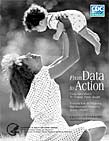|
From Data to Action: Breast-Feeding |
|
 Using Surveillance To Promote Public Health Using Surveillance To Promote Public Health
Examples from the Pregnancy Risk Assessment Monitoring System (PRAMS)
EXECUTIVE SUMMARY PUBLICATION YEAR 2002
Breast-Feeding
Breast-feeding is recognized by national and international authorities as
the single best way to feed infants.23 Breast-feeding is
associated with fewer episodes of infectious illness among infants and
healthier relationships between babies and mothers. It has also been shown
to be cost-effective for families. A meta-analysis found that breast-fed
children have higher cognitive function than formula-fed infants, especially
among low-birth-weight infants.24–28
Maine
PRAMS data on statewide breastfeeding initiation and duration prompted
staff at the Maine Medical Center (MMC, the state’s largest hospital,
accounting for 18 percent of all births) to examine breast-feeding practices
in their hospital. A study was designed and implemented in 1997. The study
results, along with a comparison with state-level findings from PRAMS, were
used to encourage the MMC to become more “baby friendly” and to initiate
stronger intervention in the Neonatal Intensive Care Unit (NICU) of the
hospital. The breast-feeding education program was expanded, and support for
lactation consultants and their programs was strengthened.
 Since
the initial study, the MMC has made a number of additional changes to
increase the breast-feeding rate in the hospital: Since
the initial study, the MMC has made a number of additional changes to
increase the breast-feeding rate in the hospital:
- Instituting the March of Dimes’ breast-feeding module in the NICU.
- Requiring all new nurses to spend time with a lactation consultant
one-on-one to get a good understanding of the referral process.
- Updating family practice residents, pediatric residents, and obstetric
practitioners regularly on breast-feeding issues.
- Convening a multidisciplinary group every other month to discuss
lactation-related issues.
- Creating a lactation consultant resource team in several units
(Obstetrics Clinic; Maternity, Labor and Delivery; Family Practice Clinic;
NICU; Pediatric Clinic; and Barbara Bush Children’s Hospital). Two nurses
from each unit are trained in lactation issues and are the designated
resources for their unit.
Return to Table of Contents
Page last reviewed: 3/24/06
Page last modified: 3/24/06
Content source: Division
of Reproductive Health,
National Center for Chronic Disease
Prevention and Health Promotion
|